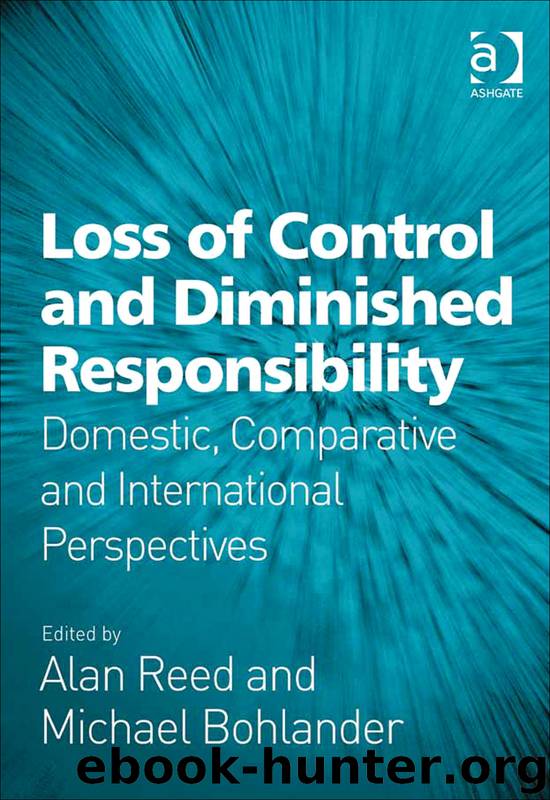Loss of Control and Diminished Responsibility by Alan Reed & Michael Bohlander

Author:Alan Reed & Michael Bohlander
Language: eng
Format: epub
Publisher: Ashgate
Published: 2010-12-31T16:00:00+00:00
The Coroners and Justice Act 2009 – Something Borrowed and Something New
The government, in setting qualifying triggers as preliminary filter devices for engagement of the new loss of self-control defence (replacing provocation), have consequently raised the discretionary bar in an exclusionary fashion. The prescribed aspiration has been to ‘raise the threshold’ so that words and conduct would constitute a defence ‘only in exceptional circumstances’.168 A by-product is that defendants in the types of ‘provocative’ situations presented in Doughty169 (stressed parent of persistently crying child), or Dryden170 (obsessional home owner embroiled in planning dispute), or Baillie171 (affronted parent of drug-dealing son) and presumptively Morhall172 (glue-sniffing addiction) are no longer within the operational purview of the defence as falling far below the threshold standard(s) of fear or justifiable anger. Maria Eagle, Parliamentary Under Secretary of State for Justice, set out the new terms in the following explicit fashion:
What we, therefore, sought to do in respect of the change to a provocation defence is to raise the threshold generally, so that those who kill in anger can succeed in having their conviction reduced to manslaughter only in exceptional circumstances. So, we are raising the bar of the availability of that defence and extending it to cover those who kill in fear of serious violence as well as those who kill in anger.173
The new partial defence of loss of self-control contains a remodelled ‘reasonable person’ test, derived in part from Camplin/Holley in terms of ‘control’ elements, but obviates explicit reference to the taunt/characteristic linkage purveyed in Morhall. To the extent that control/response characteristics are relevant at all they have been coalesced together in a fudged merger. The ambit of permissible provocative conduct, in any event, is restrictively circumscribed as the accused’s loss of self-control must be attributable to (i) a fear of serious violence174 or (ii) circumstances of an extremely grave character which cause a justifiable sense of being seriously wronged.175 In the latter context the law has broadly shifted away from the excusatory nature of the gravity of the provocation to the particularised defendant via the direct link of taunt and characteristic, and looks instead at partly condonable anger as a derivative of actions or words producing an insulted response.
This unchartered legislative sea change, as all key concepts are left undefined, has been expertly summarised as a shift from ‘compassionate excuse’ towards ‘imperfect justification’176 with a new moral and social barometer of partly appropriate anger; ‘under the new ethical approach … sympathy for human frailty is rejected in favour of a recognition of imperfectly justified anger. Anger is partially rightful … it is the imperfectly valid moral connection between the provocation and the response that is relevant. Provocation causally links the anger felt to the deed done or words said.’177 A marked shift towards objectification has occurred throughout the new reforms: the trial judge can unilaterally remove the defence on the premise that no properly directed jury could reasonably conclude its applicability;178 sexual infidelity is excluded;179 incited, directed violence is outwith the new parameters;180 and revenge is inconsistent with the ambit of the defence.
Download
This site does not store any files on its server. We only index and link to content provided by other sites. Please contact the content providers to delete copyright contents if any and email us, we'll remove relevant links or contents immediately.
The Borden Murders by Sarah Miller(4029)
The Secret Barrister by The Secret Barrister(3428)
Coroner's Journal by Louis Cataldie(2364)
Police Exams Prep 2018-2019 by Kaplan Test Prep(2363)
The Splendid and the Vile by Erik Larson(2232)
Terrorist Cop by Mordecai Dzikansky & ROBERT SLATER(1966)
My Dark Places by James Ellroy(1807)
A Colony in a Nation by Chris Hayes(1799)
Black Klansman by Ron Stallworth(1707)
The Art of Flight by unknow(1697)
A Life of Crime by Harry Ognall(1598)
Objection! by Nancy Grace(1572)
The New Jim Crow by Michelle Alexander(1552)
Whoever Fights Monsters by Robert K. Ressler(1540)
Anatomy of Injustice by Raymond Bonner(1533)
Invisible Women by Caroline Criado Perez;(1521)
Obsession (The Volkov Mafia Series Book 1) by S.E Foster(1499)
American Prison by Shane Bauer(1483)
A is for Arsenic: The Poisons of Agatha Christie (Bloomsbury Sigma) by Kathryn Harkup(1458)
